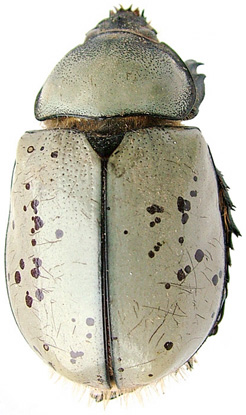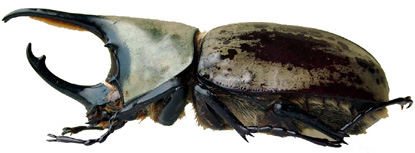 |
|||||||
|
|||||||
male, dorsal view
female, dorsal view
male, lateral view
female, lateral view
Photos by Mathew R. Moore
|
||
|
|
||
| Dynastinae Taxa Map | ||
| Dynastini key | ||
| Pentodontini key |
Distribution: Southwestern United States: Arizona, New Mexico, Utah and northern Mexico (Chihuahua).
Description: Pronotal horn in male majors longer than pronotum, horn triangularly excised at apex (dorsal view). Clypeal horn with dorsal tooth near apex (lateral view). Elytra and pronotum glabrous and bluish-gray or pale olive in both sexes. Female clypeus not constricted laterally and weakly emarginated at apex.
Biological Data: Dynastes grantii is the largest scarab in the western United States and is relatively common in Arizona. During the day adults can be found stripping the bark from velvet ash, Fraxinus velutina Torrey (Oleaceae), and feeding on sap (Menke 1988). Adults exhibit a defense behavior in which a brown liquid is squirted from the abdomen and directed at the perceived threat (Menke 1988). Dynastes grantii larvae have been found in rotten sycamore (Platanus racemosa Nutt., Platanaceae) (Ritcher 1966).
Temporal Distribution: Mid-August to October. Adults are most often collected at lights at night (Menke 1988).
Larvae: Ritcher (1966) described the third instar larvae.
References:
Endrödi, S. 1985. The Dynastinae of the World. Series Entomologica, Volume 28, W. Junk, Dordrecht. 800 pp., 46 plates.
Menke, S. and D. Parker. 1988. Adult feeding and distribution of Dynastes grantii Horn (Coleoptera: Scarabaeidae). Coleopterists Bulletin, 42: 161-164.
Ritcher, P.O. 1966. White Grubs and Their Allies. Oregon State University Press, Corvallis, OR. 219 pp.
|
||||
|
|




